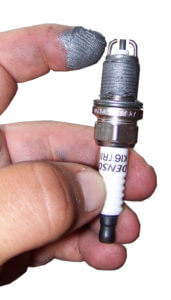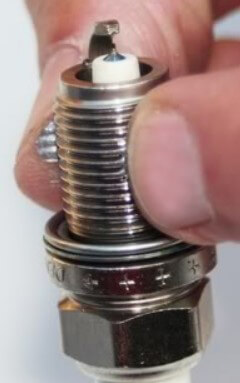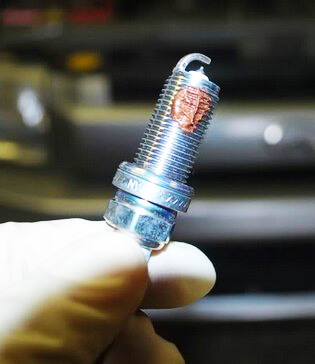Anti-seize on spark plug threads
Should you apply anti-seize on spark plug threads?
No.
Most spark plugs have either a zinc or nickel plating that prevents the threads from seizing in the cylinder head. That’s different from decades ago when spark plugs didn’t have any coating and could seize in the cylinder head, making removal tough.
Do not add anti-seize to spark plug threads
Adding anti-seize to spark plug threads actually lubricates the threads, causing you to over-tighten the spark plugs. Over-tightening causes the metal shell to distort and break the seal between the shell and the porcelain center. That causes misfires.
NGK reports that over 90% of all early spark plug failures are related to damage caused by over-torquing the spark plugs.
Using a torque wrench with dry spark plug threads is critical to preventing spark plug damage.
If you ignore this advice and apply anti-seize, you must reduce the torque setting on your torque wrench by 25%. If you don’t, you’ll over-torque the plug and damage it.

If the spark plug has a black oxide finish, it has NOT been coated at the factory and you should apply a very small amount of anti-seize to the threads
In the OLD DAYS, Copper spark plugs never needed anti-seize
In the old days when engines and cylinder heads were made from cast iron and copper spark plugs only lasted 12,000 miles, there was no need for anti-seize. The spark plugs never stayed in the engine long enough to seize in the cylinder head. Plus, they were similar materials—steel and cast iron.
Platinum spark plugs and aluminum heads changed everything
When carmakers switched to platinum-tipped spark plugs that lasted up to 100,000 miles, spark plugs started to seize in the cylinder heads. The problem got even worse as carmakers switched to aluminum cylinder heads. The dissimilar metals went through a galvanic reaction where metal transferred and welded the spark plugs to the head. When the DIYer or professional tech went to remove the spark plugs, they would often rip the threads right out of the cylinder head.
That’s when spark plug manufacturers and carmakers started recommending the application of a small dab of anti-seize on spark plug threads. That way, the spark plug could be removed easily the next time.
Add anti-seize only if you’re re-installing used spark plugs
If you’re RE-INSTALLING spark plugs, you should apply anti-seize because the factory-applied release agents are damaged upon removal. Most

Whoa dude, that’s WAY TOO much anti-seize
DIYers add WAY too much anti-seize. More is NOT better. The excess anti-seize can transfer to the electrodes, causing a misfire. The excess anti-seize causes over-tightening and spark plug

Add a tiny amount a few threads down from the tip to avoid tip contamination
shell distortion and combustion gas leaks and also spark plug thread damage in the cylinder head.
Here’s what the spark plug manufacturers say about anti-seize

Too much
NGK’s position on anti-seize
NGK spark plugs are manufactured with a trivalent plating. The spark plugs display a silver or chrome finish on the threads. The trivalent plating reduces corrosion resistance from moisture and chemicals. The trivalent coating also acts as a release agent during spark plug removal. NGK spark plugs should be installed DRY, WITHOUT anti-seize.
NGK reports that tech support personnel have received a number of calls from installers who have over-tightened spark plugs because of the use of anti-seize. Anti-seize is a lubricant and affects torque values by up to 20 percent. If you use anti-seize against NGK recommendations, you MUST decrease the set torque on your torque wrench by that amount or risk breaking the spark plug, distorting the shell, or damaging cylinder head spark plug threads.
Autolite’s position on anti-seize
Autolite does NOT recommend the use of any type of anti-seize lubricant when installing new Autolite spark plugs. Since anti-seize compounds contain metallic, electrically conductive ingredients, the ingredients can come in contact with the electrodes on the spark plugs, leading to misfires. Anti-seize lubricants also introduce a torque multiplying effect, leading to cylinder head spark plug thread distortion, galling, and cylinder head damage.
Autolite applies a nickel plating to the threads of new spark plugs that resist corrosion and seizing.
AC/Delco’s position on anti-seize
AC spark plugs should be installed dry. Do NOT use any type of anti-seize lubricant on spark plug threads. Anti-seize lubricants decrease the amount of friction between the threads, resulting in over-tightening. That can cause the spark plug to move too far into the combustion chamber (in crush washer applications). Over-tightening can also distort the spark plug shell, causing a leak which would allow blowby to pass through the gasket seal between the shell and insulator. Over-tightening also results in extremely difficult removal.
Champion spark plug position on anti-seize
Champion spark plugs are zinc plated to reduce the chance of seizure in aluminum cylinder heads. Champion then applies Tin Tac” and ULTRASEAL’M coatings over the plating to further reduce corrosion and seizure. Anti-seize should NOT be applied to new Champion spark plugs.
©, 2017 Rick Muscoplat
Save
Posted on by Rick Muscoplat